The authors are simply recommending a hammer-type preliminary turn for discus throwers as a way to increase release velocity. A study using one participent is hardly conclusive, but perhaps gives us some food for thought.
By Prof. Dr. Mostafa Atwaa , Athletics department, Physical Education Faculty, Sadat City University; Prof. Dr. Mohammed Gamal, Biomechanics Department, Physical Education Faculty, Helwan; University; Dr. Marwa Sakr, Athletics department, Physical Education Faculty, Sadat City University, Egypt.
Abstract
The aim of throwing the discus is to achieve the greatest horizontal distance as possible. Each phase of technique has its role in the resultant performance. The general trend of training programs is to improve physical fitness in order to increase the resultant distance. The authors aimed to modify throwing technique as a way to achieve greater distances in the discus throw event, in a way that doesn’t conflict with IAAF-certified throwing technique. The study was descriptive and empirical, while a comparison in some kinematical aspects was carried on between two discus trials. One was performed with the current style and the other was performed with the modified style. The participant was an Egyptian elite decathlon athlete. The results emphasized the advantages of using the modified technique, due to the mechanical advantages achieved.
The Study’s Main Idea
The main factors that affect discus throw distance are height, angle, and velocity of release. The height of release depends on the thrower’s anthropometric characteristic (physical height) and the angle of release depends on accurate technique, while the velocity of release depends on physical abilities which are improved by the training program. There is also the aspect of the length of the discus’ path from the beginning till the release; the longer this path the greater is velocity at release.
Discus throw technique has a preparatory phase (wind-up), which is in the opposite direction of the turns. As a result, the discus reaches zero velocity at the beginning of the turns then increases gradually during the turn until the release phase, which means that the shorter the duration of the turn the greater the velocity of release is (5). Therefore, the modified discus throw style is based on:
1. Prolonging the motion path of the discus.
2. Increasing the initial velocity to greater than zero by adding a turn similar to hammer throw technique (double support and single support) as a preparatory phase after wind-up (Table 1).
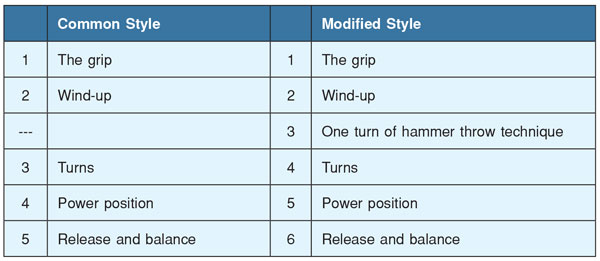
In the common discus throw style (1.5 turn), the velocity would be zero at the beginning and (x) at the release, but as a result of the modification the initial velocity would be greater than zero at the beginning of 1.5-turn. Accordingly, the release velocity would be increased by the same amount of the increment at the beginning, theoretically. That would be the first targeted change, in one of the kinematical parameters, that affects distance if the other parameters were the same.
The Purpose
1. Is the modified style applicable and legal according to the IAAF competition rules?
2. Comparing the common discus throw style (1.5 turn) with the modified style (2.5 turns) based on the kinematical parameters at the beginning of the turn and at release instance.
The Procedures
The participant in this study was an Egyptian decathlon athlete, who was second in the national championships (2007). He was 1.91m (6’3/4”) tall, 82 Kg (181lbs) in weight, 21 years old. His personal record for the discus was 41.80m (137’2”).The participant learned the modified style of discus then he threw many trials using both styles. The best of each was chosen and analyzed 3D by Motion Track program. The motion analysis was employed to:
1. Improve the ability to perform the modified style.
2. Identify the changes in the kinematical parameters during release instance.
Results and Discussion
The ability to perform the modified style
Connecting one turn of the hammer throw technique with 1.5-turn of the discus throw technique may need a skillful athlete to maintain balance, because the athlete uses the lateral quarter of the foot of the support leg during this connection. The motion path curve of the discus after modification seems to be smooth (see Figure 1), which means that it has no technical gaps or problems. This fluency could be observed by the velocity averages along the modified style motion (Table 2).

Table 2 shows that the primary velocity of the discus in the common style at the beginning of the turns was zero, while it was 4.58m/s in the modified style. This reflects the benefit of adding the support phases before the main 1.5 turn of discus throw.

Figure 1 indicated the semilinear increment of the velocity during the throw path in the two trials (the common and the modified), which confirmed the harmony of the modified style and the probability of connecting the two support phases of the hammer with the 1.5 turn of discus. In addition. Table 4 shows that the athlete was able to maintain balance after release.
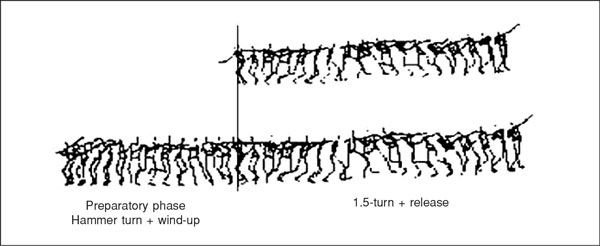
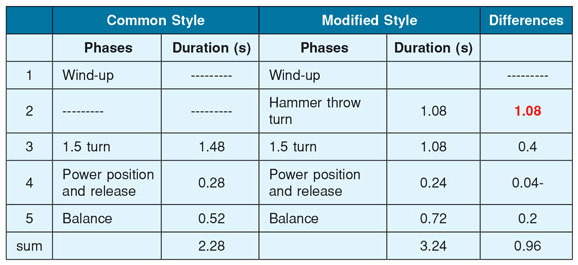
Table 3 indicates the duration of 1.5-turn in both styles. Where it was 1.48s in the common style, it was 1.08s in the modified style. The authors note the difference (0.4s) in duration for the hammer throw turn performed before the 1.5-turn which accelerates the discus entering the turn with velocity greater than zero, unlike the common style.
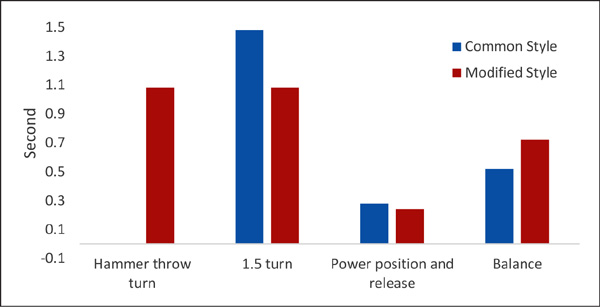

Table 4 shows the integration between footwork for the hammer throw turn and the 1.5-turn of the modified style. Figure 4 presents the contribution percentage of footwork in the modified style (30%) for the hammer throw turn and (70%) for the 1.5-turn.
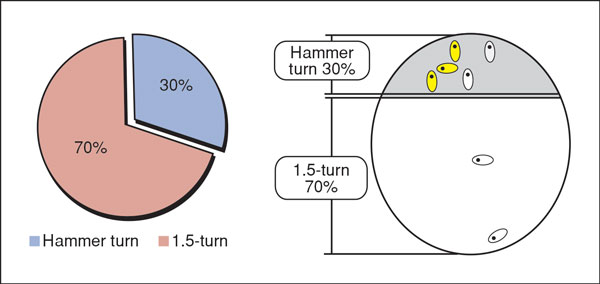
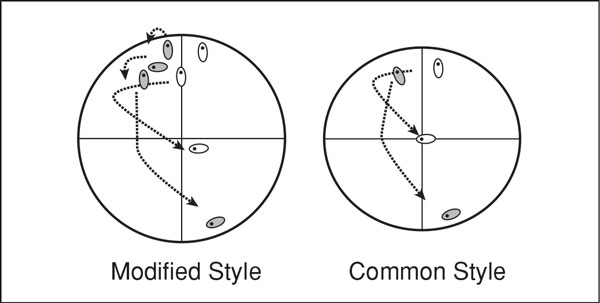
Kinematical Parameter Changes at Release
Table 5 indicates the advantage of the modified style by increasing the path length to 14.03m as opposed to 8.43m, which results in an increment of the personal record by 2.48m (see Table 6).


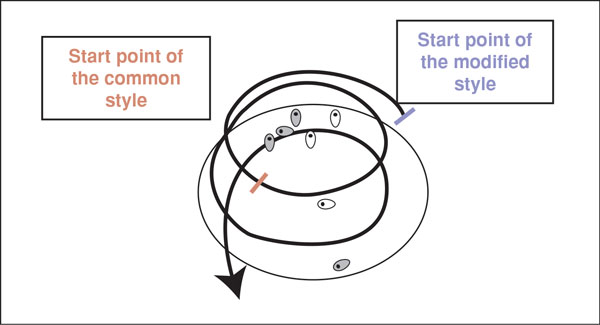
Table 6 and Figure 7 illustrates the differences between the values of velocity, height, and height of release in both styles, which shows the advantage of the modified style in release velocity which resulted in a greater thrown distance.
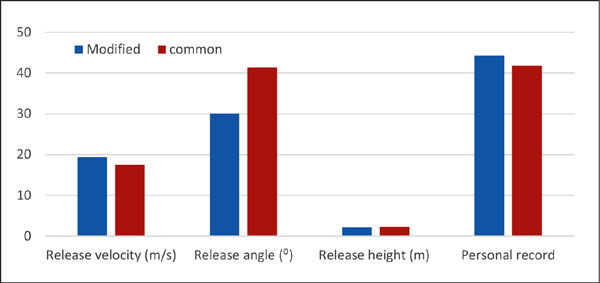
Conclusion
• The modified style throw technique is legal, acording to IAAF rules.
• The modified style in this study resulted in increasing the personal record of the participant athlete by 6% greater than his previous record.
• The modified style resulted in increasing the geometric path of the discus motion.
• The modified style resulted in increasing the release velocity by 10.75% more than the common style.
Recommendation
• We recommend teaching the athlete the new style after mastering the common style.
References
1. Duan V. Knudson & Craig Morrison: (1997) “Qualitative Analysis Human Movement”. Human Kinetics, U.S.A. 40, 55- 64
2. Gerry A. Carr: (1991) “Fundamentals of Track and Field”, University of Victoria. 110-117
3. Nancy Hamilton & Kathryn Luttgens : (2002) “Kinesiology-Scientific Basis of Human Motion”, Mc Graw-Hill Companies, 10th ed, New York, USA. 23- 30
4. Vladimir M. Zalsiorsky: (1998) “Kinematics of Human Motion”, Human Kinetics, U.S.A. 35
5. Victor M & Soto & Rojas: (1999) “Biomechanical analysis for technical consideration in hammer throwing, final championship, Asphalted (IAAF), Granada University, Spain. 137-139
6. William .J. Bowerman: (1991) High-Performance Training for Track and Field, second edition, USA, 118.